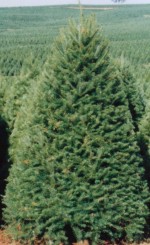
The six most popular live Christmas trees, according to the National Christmas Tree Association, are listed below with their characteristics.
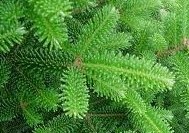
 Fraser Fir (Abies fraseri)
Fraser Fir (Abies fraseri)
Fraser fir has short, flat needles that are soft, rounded at the tip, and have a broad, circular base. The needles are dark blue-green on the top side and silvery on the underside. Fraser fir have a limited range and can be found naturally only at elevations over 4,500’ in the southern Appalachian Mountains in southwest Virginia, western North Carolina, and eastern Tennessee. It is fragrant, long lasting and is considered an outstanding Christmas tree.
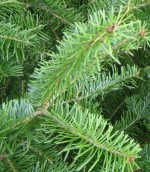
 Balsam Fir (Abies balsamea)
Balsam Fir (Abies balsamea)
Though looking very much like Fraser fir, balsam fir has short, flat needles that are borne on strong boughs. They are about 1½” long, have rounded tips, and form a feathery spray of foliage. The trees have a nice shape and are fragrant. The biggest difference between balsam and Fraser fir has to do with bracts on the cones, a characteristic that you would never notice even if the cones were on the tree at Christmas. Balsam fir thrives in cool climates, with abundant soil moisture and a humid atmosphere. It grows well from Alberta and Labrador, to New England, and south as far as Pennsylvania at elevations below 5,000’.
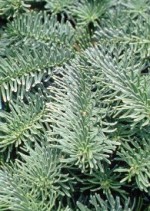
 Noble Fir (Abies procera)
Noble Fir (Abies procera)
Even in the wild these trees have a beautiful symmetrical shape. Added to that are the blush-green silvery needles over 1 inch long that are twisted upward and densely packed on the stem so that the lower surface of the branches are visible. The branches are stiff and able to hold the weight of substantial ornaments without sagging. The tips of the branches are often used in wreaths and table arrangements throughout the country. Noble fir is native to the mountains of northern Caliornia, Oregon and Washington.
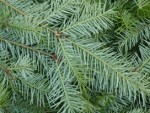
 Douglas Fir (Pseudotsuga menziesii)
Douglas Fir (Pseudotsuga menziesii)
Although called a fir, this is not a fir at all as can be seen by the genus name Pseudotsuga. Still, it is one of the most popular Christmas trees throughout the whole country and is even shipped overseas. The unique characteristic of the tree is its horizontal branches with pendulous branchlets that give it a graceful drooping look. Shearing reduces the appearance of this characteristic. The soft needles are 1 to 1 ½” long, dark yellow-green to bright green to bluish-green, and are spread along the stems in all directions. A native of the central California, western Oregon and Washington, parts of the Rocky Mountains, and Alaska, Douglas fir has been the most popular Christmas tree in the Pacific Northwest since the 1920s. Although trees in past years were harvested from forests, most Christmas trees today are grown and harvested on tree farms.
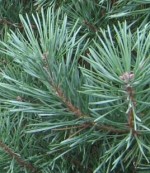
 Scotch Pine (Pinus sylvestris)
Scotch Pine (Pinus sylvestris)
A native of Europe and Asia, Scotch pine was introduced into North America by European settlers and is grown in both the eastern U.S. and Canada for Christmas trees. The dark green needles are 1½ ” to 3” long, borne in clusters of two, and are usually twisted, stiff and flattened, The branches are stiff and especially well adapted to holding ornaments. Scotch pines hold their needles well and remain attractive through harvest and shipping.
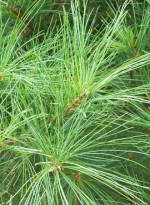
 White Pine (Pinus stobus)
White Pine (Pinus stobus)
The needles of white pine are blue-green to silver-green, 1½” to 5” long, and are soft, flexible and borne in clusters of five. The branches are also flexible and tend to droop when hung with ornaments. The over all appearance of the tree is light and airy although shearing can create a compact bushy plant. Compared to other Christmas trees it has little scent, a positive characteristic for those who suffer from allergies. It grows from Newfoundland to Manitoba, through northern U.S. to eastern Ohio, and then south to Georgia and South Carolina in the Appalachian Mountains, below 5,000 feet.
Most of the Christmas trees you find for sale will have been sheared into a pyramid shape and are nice and bushy. Color, texture, and needle retention are the characteristics to look at. Many conifers including spruce and yew are not mentioned because the shed their needles or loose their color when cut and brought inside. Other good Christmas trees were not included because their range is so small that they are not readily available. In general, firs and pines make the best live Christmas tree because of their color, needle retention, and their ability to support ornaments.
See also my post about Making your Christmas tree last longer for the holidays.
